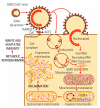SARS-CoV-2: From Structure to Pathology, Host Immune Response and Therapeutic Management
- PMID: 32987852
- PMCID: PMC7600570
- DOI: 10.3390/microorganisms8101468
SARS-CoV-2: From Structure to Pathology, Host Immune Response and Therapeutic Management
Abstract
Coronaviruses are large, enveloped viruses with a single-stranded RNA genome, infecting both humans and a wide range of wild and domestic animals. SARS-CoV-2, the agent of the COVID-19 pandemic, has 80% sequence homology with SARS-CoV-1 and 96-98% homology with coronaviruses isolated from bats. The spread of infection is favored by prolonged exposure to high densities of aerosols indoors. Current studies have shown that SARS-CoV-2 is much more stable than other coronaviruses and viral respiratory pathogens. The severe forms of infection are associated with several risk factors, including advanced age, metabolic syndrome, diabetes, obesity, chronic inflammatory or autoimmune disease, and other preexisting infectious diseases, all having in common the pre-existence of a pro-inflammatory condition. Consequently, it is essential to understand the relationship between the inflammatory process and the specific immune response in SARS-CoV-2 infection. In this review, we present a general characterization of the SARS-CoV-2 virus (origin, sensitivity to chemical and physical factors, multiplication cycle, genetic variability), the molecular mechanisms of COVID-19 pathology, the host immune response and discuss how the inflammatory conditions associated with different diseases could increase the risk of COVID-19. Last, but not least, we briefly review the SARS-CoV-2 diagnostics, pharmacology, and future approaches toward vaccine development.
Keywords: COVID-19; SARS-CoV-2; immune response; inflammation.
Conflict of interest statement
The authors declare no conflict of interest.
Figures




References
-
- Cascella M., Rajnik M., Cuomo A., Dulebohn S.C., Di Napoli R. StatPearls. StatPearls Publishing; Treasure Island, FL, USA: 2020. Features, Evaluation and Treatment Coronavirus (COVID-19) - PubMed
Publication types
Grants and funding
LinkOut - more resources
Full Text Sources
Miscellaneous

